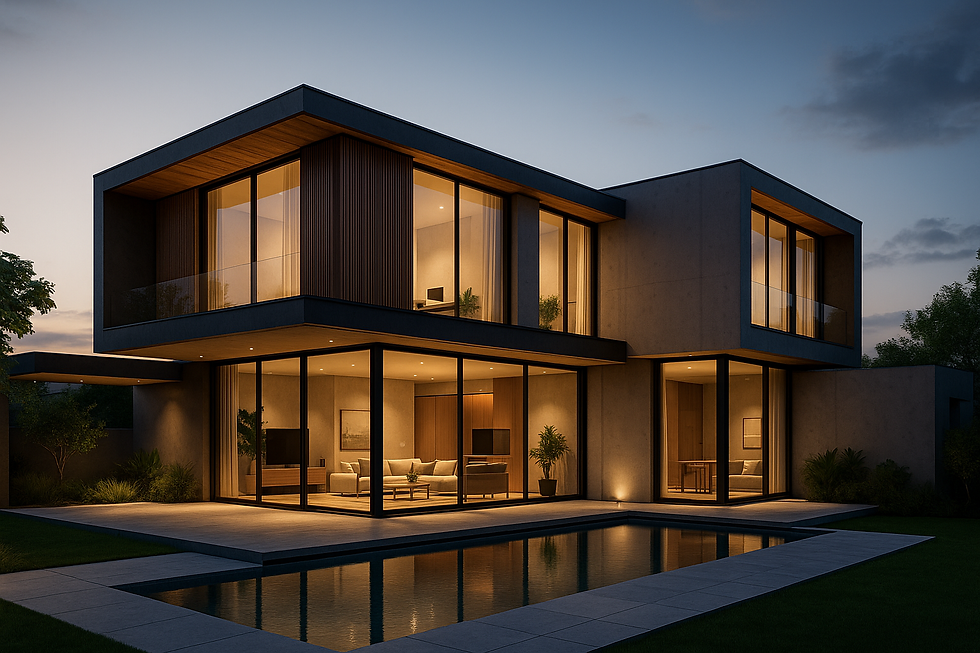Sustainable Interior Design: 5 Eco‑Friendly Trends to Make Your Home Greener
- Team DRS
- May 2
- 3 min read
Bringing eco‑conscious practices into your home isn’t just a fad—it’s a movement backed by data. Google Trends identifies upcycling and chemical recycling among the fastest‑growing sustainability search clusters in early 2025, reflecting a true shift in consumer priorities. Meanwhile, 1stdibs’ 2025 Designer Trends Survey reports that 43% of upcoming interior projects will require sustainability elements, underscoring that green credentials are now a design must‑have. To help you leverage this momentum, here are five eco‑friendly trends—plus practical tips and an inspiring case study—that will transform any space into a healthier, more sustainable haven.

Designers and homeowners alike are embracing sustainable interiors not just for their aesthetic appeal but for their positive environmental impact. From material choices to décor strategies, “green” is the new black in home design. In this post, we’ll dive deep into the five top trends—vegan leathers, reclaimed wood furniture, non‑toxic paints, biophilic elements, and upcycled décor—that promise to make your home both stylish and planet‑friendly.
Top 5 Eco‑Friendly Trends
1. Vegan Leathers
Plant‑based vegan leathers are rapidly displacing traditional hides, offering cruelty‑free upholstery without compromising on style. The global plant‑based vegan leather market was valued at USD 5,055.5 million in 2024 and is projected to reach USD 5,424.6 million in 2025, reflecting growing demand for sustainable materials. Leading PETA‑endorsed vegan sofas showcase animal‑friendly materials that rival real leather in durability and comfort. Retailers such as Wayfair and Amazon now carry dozens of vegan leather sofa options—from sleek modern designs to cozy traditional silhouettes—making it easier than ever to shop cruelty‑free.
2. Reclaimed Wood Furniture
Reclaimed wood transforms discarded timber into one‑of‑a‑kind furniture pieces while significantly reducing deforestation.

Materials like reclaimed barn wood, salvaged beams, and repurposed factory boards are prized for their unique patina and history, all with a minimal environmental footprint. According to a recent industry report, the global reclaimed lumber market is poised to grow as more consumers seek eco‑friendly building materials and décor, reinforcing its status as a durable, sustainable alternative to new wood.
3. Non‑Toxic Paints
Indoor air quality is crucial for health, and choosing the right paint can make all the difference. Benjamin Moore’s Eco Spec® is their “greenest” interior premium paint line, featuring zero VOCs (volatile organic compounds) and zero emissions—ideal for eco‑responsible projects. It also holds both Green Seal and asthma & allergy friendly® certifications, ensuring that it meets rigorous standards for performance and air‑quality safety.
4. Biophilic Elements
Biophilic design taps into our innate affinity for nature by integrating natural light, living plants, and organic materials into interior schemes. Studies show that environments enriched with biophilic elements can reduce stress, boost mood, and enhance cognitive function by up to 37%. Whether through a lush indoor garden, floor‑to‑ceiling windows, or timber accents, biophilic interiors create healthier, more restorative living spaces.

5. Upcycled Décor
Upcycling breathes new life into everyday objects, turning potential waste into striking décor. Market research firm Spate identifies upcycling as one of the top‑growing sustainability trends in Google searches, highlighting its cultural momentum. From converting old ladders into floating shelves to crafting candleholders from vintage glass jars, simple DIY upcycled projects can add unique character to your home while cutting down on landfill waste.
Practical Tips: Your Sustainable Shopping Checklist
FSC‑Certified Wood: Choose furniture and millwork carrying Forest Stewardship Council certification to ensure responsible forestry practices.
Low/Zero VOC Paints: Look for Green Seal, LEED, and asthma & allergy friendly® labels when selecting paints and finishes.
Eco‑Leather Standards: Opt for plant‑based leathers with third‑party endorsements (e.g., PETA‑Approved Vegan) to guarantee animal‑friendly sourcing.
Material Longevity: Prioritize durable, timeless designs that extend product life cycles and reduce turnover.
Third‑Party Eco Certifications: Check for Cradle to Cradle Certified® products to ensure circular‑economy principles and material health.
Case Study: A Vibrant Vegan Home Makeover
Designer Kishani Perera’s recent Los Angeles project exemplifies how a home can be entirely vegan and sustainable without sacrificing color or personality. Perera meticulously vetted every material—from non‑toxic, plant‑based paints to vegetable‑dye textiles and cotton‑filled seating—to create a vibrant, cruelty‑free interior that feels as inviting as it is ethical. Her design demonstrates that sustainable choices can yield bold, joyful spaces that champion both human and animal welfare.
Call to Action
Ready to bring these eco‑friendly trends into your own home? Contact Dimension Rendering and get your space designed—complete with vetted product sources, planning worksheets, and expert insights—to start your green interior journey today.





Comments